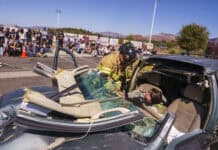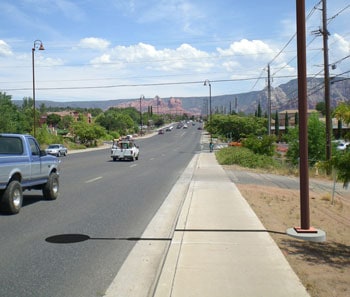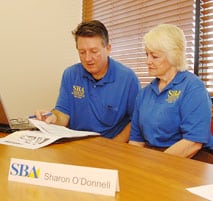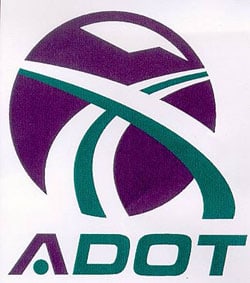On both sides of the fence — literally and figuratively — millions debate the far-reaching implications of the U.S. government’s policies toward immigration.
By Tyler Midkiff
Larson Newspapers
On both sides of the fence — literally and figuratively — millions debate the far-reaching implications of the U.S. government’s policies toward immigration.
Some champion the virtues of an open border between the United States and Mexico while others stand on or near the fence unsure of the right thing to do.
There are others who believe in tightening border restrictions, and a few, adamant that something should be done, have joined groups like the Minuteman Project and volunteered to stand watch at the border.
Sedona resident Kitty McKenzie recently returned from her first tour of duty with the Minuteman Project, a group founded in 2005 to slow the flow of illegal immigrants across the border.
For five days, McKenzie was stationed near Sasabe, a small border town in the Altar Valley just west of Nogales.
It’s a busy corridor, according to Richard Dewitt, a public information officer for the Tucson sector of the Border Patrol.
"The potential for dangerous encounters is very high there," Dewitt said.
McKenzie’s group, which consisted of about 50 men and women, spread out along the border. On a private ranch, about 150 yards apart, they camped — and waited.
Like most others in the group, McKenzie carried a gun. She was strongly cautioned about using it, she said — only if her life were in immediate danger.
People hoping to cross the border travel mostly at night, so that’s when the Minutemen are the most vigilant.
"Coyotes" — young men paid to guide people across the border — move fast, so their passengers are constantly dropping things along the way to keep up.
The trails are littered with items people were forced to leave behind.
Women’s underwear and bras hang from the trees as trophies of the coyotes who sexually abuse their female "passengers," according to McKenzie, who offered pictures as proof.
"They’re inhuman," Dewitt said of the coyotes. "They care nothing about human life. They’re in it just for the money."
Those whom they guide across the border are usually ill-prepared for the journey and many of them have health problems.
"If they fall behind, they’re usually just left there," Dewitt said.
This year alone, the Minutemen have found more than 300 people wandering through the desert by themselves, abandoned by their group, according to McKenzie.
At night, McKenzie and others scanned the terrain with night-vision goggles. When the illegal aliens, or "IAs," get close, the volunteers cast spotlights on them, McKenzie said.
The coyotes will usually run. They know the terrain, so they can find their way around, but the people they’re bringing across are usually tired, hungry, thirsty, cold and essentially clueless about where they are, McKenzie said.
Some of IAs may run as well, but the Minutemen are told not to go after them.
The Minutemen don’t capture or detain anybody, according to McKenzie. They wait for Border Patrol to arrive and then point officers in the direction the IAs ran.
Border Patrol takes the IAs to the nearest processing facility to run criminal background checks. Those with no criminal histories and no previous detentions at the border are offered a chance to return to Mexico voluntarily, according to Dewitt.
Anyone found with a criminal record, particularly for aggravated or felonious crimes, may face prosecution and imprisonment in American jails and prisons.
"It’s not a pretty situation for anyone involved," McKenzie said. "It’s a Catch-22 either way you look at it …. I don’t think anybody knows what the answer is right now."
However, federal and state authorities, constantly wavering on the issue, are now building a fence along the Arizona border at the rate of about 1,000 feet a day.
The fence is open air, but rugged — buried four feet down and sunk into concrete.
"It’s causing [IAs] to have to find new routes and it slows them down," McKenzie said. "It also narrows the areas that Border Patrol has to watch."
McKenzie said she’s less concerned about people who cross the border to find better jobs. She’s more worried about the criminal element — people fleeing Mexican authorities or looking to get involved in gangs or narcotics.
McKenzie said she doesn’t fault people like President George W. Bush or former Mexican President Vincente Fox who have referred to the Minutemen and other similar groups as vigilantes.
She understands why people are concerned about armed citizens at the border, but McKenzie said she was impressed with the level of caution those in her group exercised.
There was no alcohol allowed on the premises and Minutemen were told not to take their guns out of their holsters for any reason, unless their lives were threatened, McKenzie said.
The Minutemen don’t want hotshots or cowboys out there looking for thrills or ways to carry out racial violence, McKenzie said.
Her group was told that organizations like the American Civil Liberties Union would exaggerate anything Minutemen members did wrong, McKenzie said.
There’s a history of vigilantism along the U.S.-Mexico border and the ACLU is concerned about violence against immigrants, said Alessandra Soler Meetze, executive director of the Arizona chapter of the ACLU.
The ACLU is not a flippant organization, Meetze said. It documents facts and activities that can be verified.
People have a right to express their opinions no matter what they are, and whether or not there’s a racist element involved is irrelevant, she said. There’s a difference between beliefs and actions.
The ACLU is concerned only about the actions of organizations like the Minuteman Project, Meetze said. That’s why, the ACLU launched a border monitoring program under the direction of Ray Ybarra in April 2005.
Ybarra is an Arizona-born Arizona State University graduate, Stanford Law School student and recipient of the Ira Glasser Racial Justice Fellowship award.
Ybarra’s program trained legal observers to monitor the actions of the Minuteman Project along the border to help deter violence and Meetze said she believes it was helpful.
The ACLU was able to build coalitions and heighten awareness about activities at the border, but the program was discontinued after a year when Ybarra returned to school, Meetze said. At the moment, due to costs, there are no plans to resurrect it.
According to McKenzie, the people in the group volunteered with the Minuteman Project because they were genuinely concerned about what they believe is happening in America.
They’re united by a belief that the government isn’t doing enough about what’s going on at the border, McKenzie said.
"What’s right? I don’t know," she said.
"I just feel like, when you look at the number of people who have been through the paperwork and done all the things that they have to do to get into this country legally, then is it fair?" McKenzie asked.
During McKenzie’s five days with the Minuteman Project, she claims her group stopped nearly 50 people from crossing the border.
McKenzie may return to the border some day, she said, but if the fence is ever completed, there may be no need for her.
Tyler Midkiff can be reached at 282-7795, Ext. 122, or e-mail to tmidkiff@larsonnewspapers.com.






















